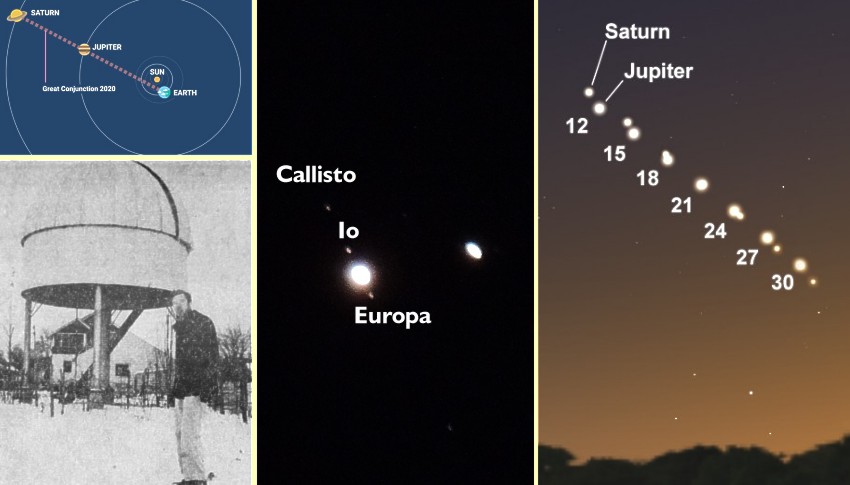Kansas Snapshots by Gloria Freeland - December 25, 2020
A special Christmas present
For a Christian, Christ's birthday is one of the most important days of the year, and the "Star of Bethlehem" has long played an
important part in the Christmas story. While the numbering of our years is based on Christ's birth, changes in the calendar and
other factors mean the precise date might be off by several years. Joe Rao, writing for space.com, explained how an unusual visual
alignment of Jupiter and Saturn might have created the storied "star."
... one of the more popular theories for the "Christmas Star" was a series of conjunctions between Jupiter and Saturn in 7 BC. For
in that year Jupiter and Saturn met not once but three times ...
The first conjunction (on May 29 - visible "in the east" before sunrise) presumably started the Magi on their way to Bethlehem from
the Far East. The middle conjunction (September 30) may have strengthened their resolve in the purpose of their journey, while the
third and final conjunction (Dec. 5) occurred just as they arrived in Judea to meet with King Herod, who sent them on to Bethlehem
to "go and search diligently for the young child."
From here on earth, the two planets appear to pass near each other every 20 years. But some of these are much closer than others.
While the one this year did not match the triple conjunction of 7 BC, it, too, was unusual. It was in 1623 - nearly 400 years ago -
the planets appeared to pass as close as they did this December - an astronomical event known as a "Great Conjunction." Two
additional aspects make it even more special. It's been nearly 800 years since the alignment occurred at night so almost everyone
on the planet could witness it. Furthermore, it occurred on the shortest day of the year - the start of winter in the northern
hemisphere.
Neither husband Art nor I normally think much about the heavens, but when I mentioned the conjunction to him, he shared a story
about the neighbor who lived across the street when he was a youngster in his hometown of Appleton, Wisconsin.
Jerry was 13 years older, but still a teenager when he developed an interest in astronomy and decided to make a telescope.
He machined all the metal pieces himself and hand-ground all the lenses - a process that took months. For me, it was a lesson in
the value of perseverance. He later built an observatory on the garden lot his family owned next to their home. The floor stood
15 feet above the ground, and the top of the moveable dome sections, made from a silo roof, was about 15 feet higher. It contained
five telescopes. He added gears and electric motors to the largest to compensate for the earth's rotation.
He occasionally set up his smaller telescopes in his driveway and neighbors came. I remember looking at Jupiter and seeing Saturn
with its rings and some of their moons. I was far more impressed than with any pictures I've seen since. While looking at the moon
was cool, I thought seeing Saturn and Jupiter was particularly impressive. They looked like polished gold against a pitch-black
background dotted with stars.
The Big Dipper, Little Dipper and the North Star are about the only things I recognize in the night sky, although I will at times
notice Venus - the "evening star." Still, I knew I wanted to see this year's special "Christmas conjunction." It made me think
of one night when our "German kids" Nadja and Tim were visiting. They just stood in our driveway looking at the stars. It was
something they could not see in the nightime sky of Berlin, which is always awash with the city's lights.
So I began scoping out the planets from our deck on Dec. 16. Jupiter was a bright light above the crescent moon, while Saturn
appeared to be a faded dot slightly to the left of Jupiter. I went to a nearby park on Dec. 19, thinking I might get a better view,
but a line of trees obscured the planets as they were too close to the horizon. When I returned home. I noticed the planets
appeared to be almost directly west of the moon.
This past Monday - the climactic day - Art and I headed north from our home to find a good vantage point from which to view the
conjunction. He settled on North 52nd Street, a gravel country road about three miles from home. While I took a few grainy pictures
with my cell phone, he mounted my Nikon 35-mm onto a small tripod and set them on the roof of our van. He manually set the focus
at "infinity," zoomed in and set the shutter for a timed release so he could take his hands off the camera to avoid shaking it.
The set up took some time, so with our binoculars, I kept moving between gazing at the planets and the moon. The latter looked
like a half slice of pie, while Jupiter was a bright point and a dim Saturn appeared to be a bit above it.
Friend Deb had an even better view, thanks to her neighbor.
"It was fabulous to see the 'Star of Bethlehem' through my neighbor's telescope," she told me. "You could see the rings around
Saturn and three of Jupiter's four moons."
The grand conjunction was a wonderful reminder of the natural beauty of the universe. But it seemed a bit more. While Christmas,
a season of love, goodwill and peace, is always nice, this rare celestial event seemed like a special present to help say "goodbye"
to this unusually tumultuous year.
